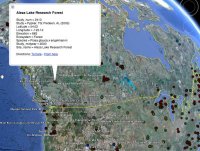Atmospher Sci & Global Chg
Research Highlights
April 2010
Even Soil Feels the Heat
Soils release more carbon dioxide as the globe warms
 Researchers overlaid the soil respiration database, openly available for the scientific community to add to, on Google Earth. Enlarge Image
Researchers overlaid the soil respiration database, openly available for the scientific community to add to, on Google Earth. Enlarge Image
Results: As the Earth grows warmer, plants and microbes in the soil release more carbon dioxide, Pacific Northwest National Laboratory scientists Ben Bond-Lamberty and Allison Thomson have discovered from a survey of twenty years of field studies. The analysis of past studies, published in the March 25, 2010, edition of Nature magazine, reveals that soil respiration has increased about one-tenth of 1 percent per year since 1989. "There's a slowly increasing flow of carbon dioxide coming off of the surface of the soil everywhere in the world, linked to warmer air temperatures" said Bond-Lamberty. Bond-Lamberty and Thomson, working at the Joint Global Change Research Institute (a partnership between PNNL and the University of Maryland) also calculated the total amount of carbon dioxide coming from soils.
Why it matters: Carbon dioxide—a heat-trapping gas that contributes to the greenhouse gas effect in the atmosphere—is mainly thought of as the result of burning fossil fuels. But as the earth heats up, carbon dioxide emissions increase in a number of less infamous ways. Soil respiration, a natural process in which carbon dioxide is released from the soil into the atmosphere, can be influenced by several factors. One of those ways is rising global temperatures. Understanding the source and mechanisms of that increased soil respiration can advance our knowledge about global climate change.
Methods: Researchers knew that soil respiration—the biochemical reaction of soil plants and microbes producing carbon dioxide—would theoretically be affected by a rise in soil temperature. This increase would result in more carbon dioxide being released from the soil. But soil respiration can't be measured from space and isn't effectively simulated with computer models. So the researchers turned to past studies published between 1989 and 2008. Using standardized methods to compile the existing data into an openly available database, they compared and analyzed the data with temperature and precipitation information in defined geographic regions.
Researchers found that the total amount of carbon dioxide emitted from soil in 2008 was more than in 1989. They also broke down the complete data set by regional climates and re-examined these smaller groups. Their analysis showed consistent results in the temperate and tropical climates, compared to the overall results, but not for the boreal-Arctic climate.
What's next: By examining the data by regional climates, researchers have identified an area for further research. The regional analysis shows the need for more boreal data on regional climates to reach statistical relevance. It will also be useful to compare these data with results produced by global climate models.
For more information: Read PNNL's press release announcing this research.
Acknowledgments: The Pacific Northwest National Laboratory is transforming the nation's ability to predict climate change and its impacts. This research was supported by Pacific Northwest National Laboratory and by the Office of Biological and Environmental Research for the Department of Energy's Office of Science. The Joint Global Change Research Institute is a partnership between the Department of Energy's Pacific Northwest National Laboratory and the University of Maryland.
Research team: Dr. Ben Bond-Lamberty and Allison M. Thomson of the Joint Global Change Research Institute.
Reference: Bond-Lamberty B and A Thomson. 2010. "Temperature-associated Increases in the Global Soil Respiration Record." Nature 464:579-582. DOI:10.1038/nature08930.
